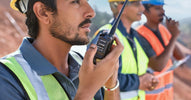
Understanding the Three Tiers of Digital Mobile Radios (DMR)
, by Jesus Moraga, 5 min reading time

, by Jesus Moraga, 5 min reading time
Digital mobile radios (DMR) have revolutionized communication, offering scalable systems that meet a wide range of business needs. From small companies to large enterprises, DMR provides dependable, high-quality communication, streamlining operations across industries.
Choosing the right DMR system depends on understanding the three distinct tiers. Designers create each tier to meet different user requirements, offering varying levels of functionality and scalability. Understanding the three tiers of digital mobile radios (DMR) helps businesses identify which system best aligns with their needs for seamless communication.
This guide will cover the applications of each DMR tier, providing insights for decision-makers to choose the most suitable system for their organization.
Digital mobile radios (DMR) are digital communication solutions developed by the European Telecommunications Standards Institute (ETSI) to offer a more efficient and cost-effective alternative to analog radio systems. DMR radios provide better audio quality, enhanced spectrum efficiency, and additional features such as text messaging, GPS tracking, and encryption.
DMR systems convert audio signals into digital data packets, reducing interference and ensuring clearer, more reliable transmissions. This technology allows for additional features like encryption, remote monitoring, and group communication, making DMR systems versatile for various industries.
Developers divide DMR systems into three tiers, with each tier offering different levels of complexity and scalability to meet the unique needs of businesses and organizations.

DMR Tier I radios operate within unlicensed frequency bands, making them accessible and affordable for smaller businesses or personal use. Designers build Tier I for short-range communication in environments that prioritize simplicity and ease of use.
Tier I radios do not require a license, making them perfect for small businesses or recreational activities that do not need complex infrastructure. These radios offer a short communication range, suitable for local communication within a building or small event. Tier I options support basic functions like simple voice communication and may even include digital text messaging but will most likely not have advanced features like encryption or multi-channel support.
Tier I is commonly used in industries such as hospitality, event management, and security, where straightforward communication is needed within a small area. However, Tier I lacks the scalability and security features that larger operations require, which makes it less suitable for expanding businesses.
DMR Tier II radios operate on licensed frequencies, offering greater range and enhanced functionality compared to Tier I. Professionals use Tier II systems in environments that require reliable communication across a larger area.
Users must obtain a frequency license to operate Tier II radios, which ensures communication occurs on regulated frequencies with minimal interference. They also support the use of repeaters, allowing for a larger coverage area, which is necessary for businesses with more extensive communication needs. This advanced gear uses time-division multiple access (TDMA) technology, enabling two simultaneous conversations on the same frequency to maximize spectrum efficiency. Their features also include digital text messaging, GPS tracking, and encryption for secure communication.
Tier II is commonly used in industries like transportation, logistics, construction, and manufacturing. For example, fleet management systems rely on Tier II radios for communication between vehicles, while construction sites use them to coordinate workers across large areas. While Tier II provides more robust functionality and security than Tier I, it requires licensing and setup, making it more complex to implement. However, the benefits of improved coverage, efficiency, and security make it a strong choice for professional use.

DMR Tier III represents the most advanced option, designed for large-scale operations that require trunked communication systems. Tier III radios operate on licensed frequencies and offer the highest level of scalability, functionality, and integration.
Unlink Tier II, which uses fixed channels, Tier III dynamically allocates channels based on demand, optimizing resource usage across the network. This option supports a range of sophisticated features like dispatch communication, group calling, GPS tracking, telemetry, and remote monitoring. Tier III also is capable of accommodating large numbers of users and devices, making it great for organizations that need extensive coverage. Lastly, they are able to integrate with data applications, providing businesses with the ability to combine voice communication with telemetry, fleet management, and monitoring.
Industries such as public safety, utilities, and large-scale manufacturing use Tier III for mission-critical communication. For instance, police departments and emergency responders rely on Tier III systems for real-time communication during emergencies, while utility companies use them to manage infrastructure and coordinate repair teams. Although Tier III offers unparalleled capabilities, its complexity and infrastructure requirements make it best suited for organizations with large-scale operations and the resources to manage such a system.
The three tiers of DMR differ in terms of licensing, range, functionality, and scalability. Tier I is ideal for small-scale, license-free communication with a limited range and basic features. Tier II provides enhanced features and coverage, suitable for professional use in industries requiring more robust communication. Tier III is the most advanced, offering dynamic, scalable systems for large organizations with regular emergency communication needs.
Understanding the three tiers of digital mobile radios (DMR) allows businesses to choose a communication system that meets their operational requirements. Whether your business needs simple, short-range communication (Tier I), professional-grade communication with additional features (Tier II), or advanced, scalable solutions (Tier III), selecting the right system will ensure better coordination, productivity, and security.
Atlantic Radio Communications has been a trusted distributor of professional two-way radios and GPS fleet-tracking products since 1990. As an authorized dealer for high-quality two-way radios in many name brands, Atlantic Radio Communications offers a range of solutions to meet the communication needs of businesses across industries.
With expertise in providing installation, repair, and rental services, Atlantic Radio Communications supports companies at every stage of their communication journey. For businesses seeking reliable, scalable, and secure communication solutions, contact Atlantic Radio Communications today. With decades of experience, we can provide the perfect DMR solution for your organization’s needs.